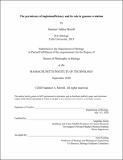| dc.contributor.advisor | Angelika Amon. | en_US |
| dc.contributor.author | Morrill, Summer Ashlee. | en_US |
| dc.contributor.other | Massachusetts Institute of Technology. Department of Biology. | en_US |
| dc.date.accessioned | 2021-01-05T23:13:32Z | |
| dc.date.available | 2021-01-05T23:13:32Z | |
| dc.date.copyright | 2020 | en_US |
| dc.date.issued | 2020 | en_US |
| dc.identifier.uri | https://hdl.handle.net/1721.1/129024 | |
| dc.description | Thesis: Ph. D., Massachusetts Institute of Technology, Department of Biology, 2020 | en_US |
| dc.description | Cataloged from student-submitted PDF of thesis. | en_US |
| dc.description | Includes bibliographical references. | en_US |
| dc.description.abstract | In diploid organisms there are two copies of every gene, one from each parent. While the majority of genes are robust to deletion of one of the two copies, a subset of genes remains highly dosage sensitive, causing a significant decrease in fitness when heterozygously deleted. These genes, known as haploinsufficient (HI) genes, are present in eukaryotic species from yeast to humans. Why haploinsufficiency persists over evolutionary time is not known. To answer this, I systematically tested two existing models of haploinsufficiency: 1) the dosage stabilizing hypothesis, which states that haploinsufficiency is caused by imbalances among protein complex members, and 2) the insufficient amounts hypothesis, which says that haploinsufficient gene products are limiting for growth. In this thesis I find that having a single extra copy of haploinsufficient genes was sufficient to cause a growth defect in Saccharomyces cerevisiae. | en_US |
| dc.description.abstract | This showed that HI genes are sensitive to both over- and under-expression. Although having an extra copy of HI genes resulted in heightened sensitivity to proteotoxic stress agents, proteotoxicity could not wholly explain the fitness defect that occurred when HI genes were heterozygously deleted. Haploinsufficiency phenotypes were still present even when all members of a complex were deleted at the once, restoring protein balance but not expression levels. In creating a new dosage sensitivity dataset by pooled fitness competition, I found that genes sensitive to increased copy number and HI genes are not mutually defined. All together, these data suggested that HI genes are unique among dosage sensitive genes, and that HI genes must also be rate-limiting for maximal growth. Many HI genes showed strong evidence of growth-limiting phenotypes, including ribosomal genes, and genes involved in protein folding. | en_US |
| dc.description.abstract | I propose a "dosage-stabilizing" model for haploinsufficiency, which states that HI genes are unable to increase or decrease their expression without fitness penalty. This is due to both the growth-limiting nature of HI genes, and to the proteotoxicity of dosage imbalance. From these two selective pressures, HI genes have very narrow ranges of expression - unable to modulate expression over time. This has caused haploinsufficiency to persist throughout the evolution of the eukaryotic genome. | en_US |
| dc.description.statementofresponsibility | by Summer Ashlee Morrill. | en_US |
| dc.format.extent | 113 pages | en_US |
| dc.language.iso | eng | en_US |
| dc.publisher | Massachusetts Institute of Technology | en_US |
| dc.rights | MIT theses may be protected by copyright. Please reuse MIT thesis content according to the MIT Libraries Permissions Policy, which is available through the URL provided. | en_US |
| dc.rights.uri | http://dspace.mit.edu/handle/1721.1/7582 | en_US |
| dc.subject | Biology. | en_US |
| dc.title | The persistence of haploinsufficiency and its role in genome evolution | en_US |
| dc.type | Thesis | en_US |
| dc.description.degree | Ph. D. | en_US |
| dc.contributor.department | Massachusetts Institute of Technology. Department of Biology | en_US |
| dc.identifier.oclc | 1227031339 | en_US |
| dc.description.collection | Ph.D. Massachusetts Institute of Technology, Department of Biology | en_US |
| dspace.imported | 2021-01-05T23:13:31Z | en_US |
| mit.thesis.degree | Doctoral | en_US |
| mit.thesis.department | Bio | en_US |
